engine oil MITSUBISHI OUTLANDER 2018 Owner's Manual (in English)
[x] Cancel search | Manufacturer: MITSUBISHI, Model Year: 2018, Model line: OUTLANDER, Model: MITSUBISHI OUTLANDER 2018Pages: 441, PDF Size: 13.71 MB
Page 12 of 441
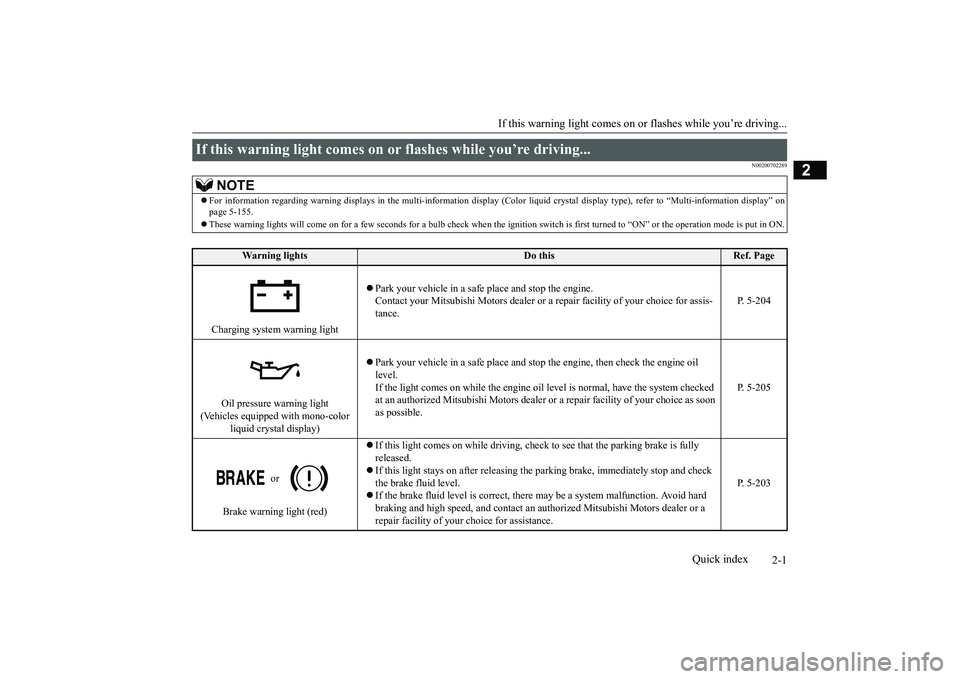
2-1
2
If this warning light comes on or
flashes while you’re driving...
Quick index
N00200702289
If this warning light comes on
or flashes while you’re driving...
NOTE
For information regarding warning
displays in the multi-information display (Color
liquid crystal display
type), refer to “Mult
i-information display” on
page 5-155.These warning lights will co
me on for a few seconds for a bulb check when the i
gnition switch is
first turned to “ON” or the op
eration mode is put in ON.
Wa rn in g l ig h t s
Do this
Ref. Page
Charging system warning light
Park your vehicle in a safe
place and stop the engine.
Contact your Mitsubishi Motors dealer or a re
pair facility of your choice for assis-
tance.
P. 5-204
Oil pressure warning light
(Vehicles equipped with mono-color
liquid crystal display)
Park your vehicle in a safe
place and stop the engine, then check the engine oil
level.If the light comes on while the engine oil le
vel is normal, have the system checked
at an authorized Mitsubishi
Motors dealer or a repair fa
cility of your choice as soon
as possible.
P. 5-205
or
Brake warning light (red)
released.If this light stays on after
releasing the parking brake,
immediately stop and check
the brake fluid level.If the brake fluid level is correct, there
may be a system malfunction. Avoid hard
braking and high speed, and contact an au
thorized Mitsubishi Mo
tors dealer or a
repair facility of your
choice for assistance.
P. 5-203
BK0249100US.book 1 ページ 2017年5月10日 水曜日 午前8時49分
Page 84 of 441
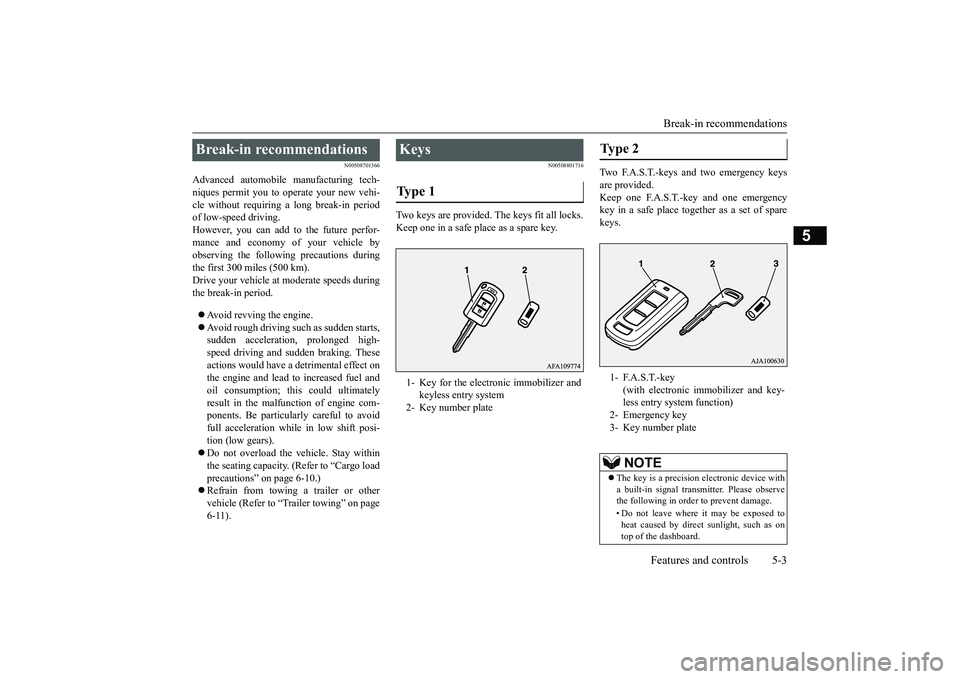
Break-in recommendations
Features and controls 5-3
5
N00508701366
Advanced automobile
manufacturing tech-
niques permit you to operate your new vehi-cle without requiring a long break-in periodof low-speed driving.However, you can add to the future perfor-mance and economy of your vehicle byobserving the following precautions duringthe first 300 miles (500 km).Drive your vehicle at m
oderate speeds during
the break-in period.Avoid revving the engine.Avoid rough driving such as sudden starts,sudden accelerati
on, prolonged high-
speed driving and sudden braking. Theseactions would have a detrimental effect onthe engine and lead to increased fuel andoil consumption; th
is could ultimately
result in the malfunction of engine com-ponents. Be particularly careful to avoidfull acceleration while in low shift posi-tion (low gears).Do not overload the vehicle. Stay withinthe seating capacity. (Refer to “Cargo loadprecautions” on page 6-10.)Refrain from towing a trailer or othervehicle (Refer to “T
railer towing” on page
6-11).
N00508801716
Two keys are provided. The keys fit all locks.Keep one in a safe place as a spare key.
Two F.A.S.T.-keys and two emergency keysare provided.Keep one F.A.S.T.-key and one emergencykey in a safe pl
ace together as a set of spare
keys.
Break-in recommendations
Keys Ty p e 1 1- Key for the electronic immobilizer and
keyless entry system
2- Key number plate
Type 2 1- F.A.S.T.-key
(with electronic im
mobilizer and key-
less entry system function)
3- Key number plate
NOTE
The key is a precision
electronic device with
a built-in signal transm
itter. Please observe
the following in order to prevent damage.• Do not leave where it may be exposed toheat caused by direct
sunlight, such as on
top of the dashboard.
BK0249100US.book 3 ページ 2017年5月10日 水曜日 午前8時49分
Page 172 of 441
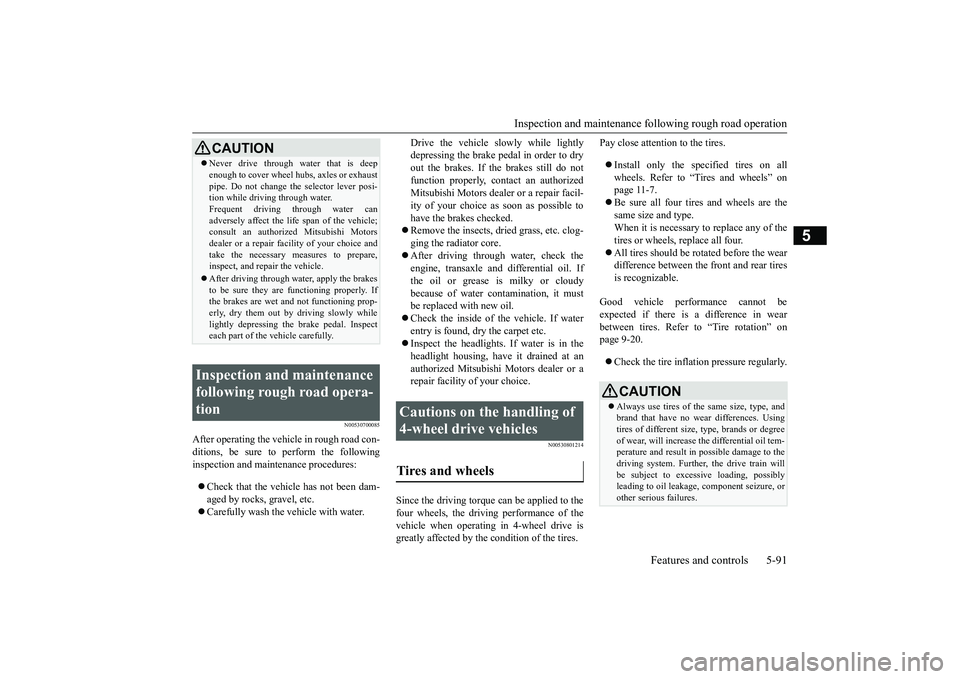
Inspection and maintenance following rough road operation
Features and controls 5-91
5
N00530700085
After operating the vehicle in rough road con-ditions, be sure to perform the followinginspection and maintenance procedures:Check that the vehicle has not been dam-aged by rocks, gravel, etc.Carefully wash the
vehicle with water.
Drive the vehicle slowly while lightlydepressing the brake pedal in order to dryout the brakes. If the brakes still do notfunction properly, contact an authorizedMitsubishi Motors dealer or a repair facil-ity of your choice as
soon as possible to
have the brakes checked.Remove the inse
cts, dried grass, etc. clog-
ging the radiator core.After driving through water, check theengine, transaxle and
differential oil. If
the oil or grease is milky or cloudybecause of water c
ontamination, it must
be replaced with new oil.Check the inside of the vehicle. If waterentry is found, dry the carpet etc.Inspect the headlights. If water is in theheadlight housing, have
it drained at an
authorized Mitsubishi
Motors dealer or a
repair facility of your choice.
N00530801214
Since the driving torque can be applied to thefour wheels, the driving performance of thevehicle when operating in 4-wheel drive isgreatly affected by the condition of the tires.
Pay close attention to the tires.Install only the specified tires on allwheels. Refer to “Tires and wheels” onpage 11-7.Be sure all four tire
s and wheels are the
same size
and type.
When it is necessary to replace any of thetires or wheels, replace all four.All tires should be rotated before the weardifference between the
front and rear tires
is recognizable.
Good vehicle performance cannot beexpected if there is a difference in wearbetween tires. Refer to “Tire rotation” onpage 9-20.Check the tire inflati
on pressure regularly.
CAUTIONNever drive through water that is deepenough to cover wheel hubs, axles or exhaustpipe. Do not change th
e selector lever posi-
tion while driving through water.Frequent driving through water canadversely affect the life
span of the vehicle;
consult an authorized Mitsubishi Motorsdealer or a repair faci
lity of your choice and
take the necessary measures to prepare,inspect, and repair the vehicle.After driving through wa
ter, apply the brakes
to be sure they are functioning properly. Ifthe brakes are wet and not functioning prop-erly, dry them out by
driving slowly while
lightly depressing the
brake pedal. Inspect
each part of the vehicle carefully.
Inspection and maintenance following rough road opera-tion
Cautions on the handling of 4-wheel drive vehicles Tires and wheels
CAUTIONAlways use tires of th
e same size, type, and
brand that have no wear differences. Usingtires of different size,
type, brands or degree
of wear, will increase the differential oil tem-perature and result in
possible damage to the
driving system. Further, the drive train willbe subject to excessi
ve loading, possibly
leading to oil leakage, component seizure, orother serious failures.
BK0249100US.book 91 ページ 2017年5月10日 水曜日 午前8時49分
Page 286 of 441
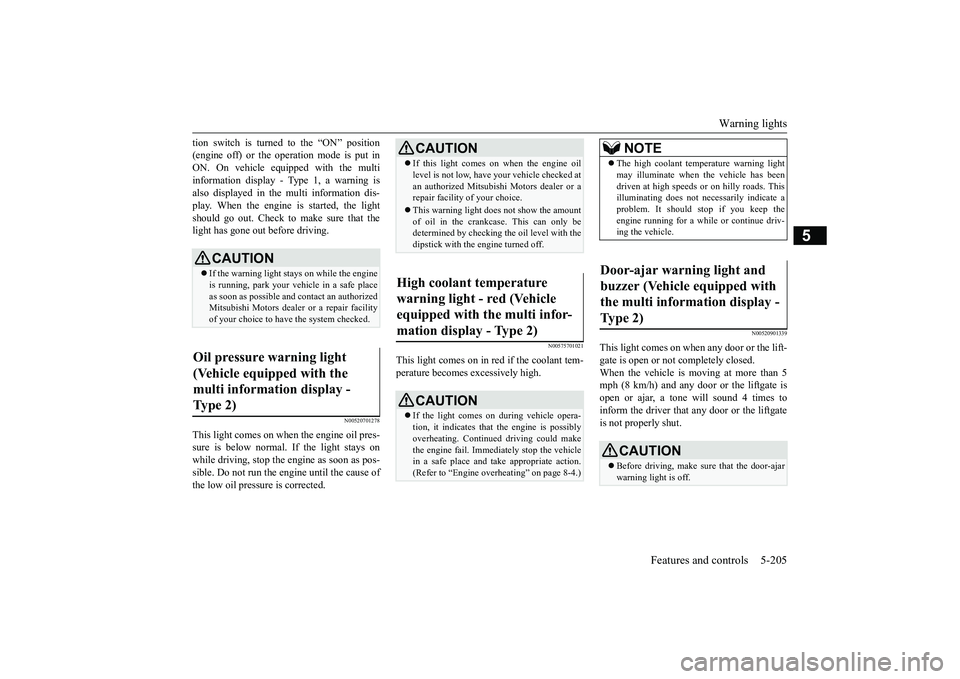
Warning lights
Features and controls 5-205
5
tion switch is turned to the “ON” position(engine off) or the operation mode is put inON. On vehicle equipped with the multiinformation display - Type 1, a warning isalso displayed in the multi information dis-play. When the engine is started, the lightshould go out. Check to make sure that thelight has gone out before driving.
N00520701278
This light comes on when the engine oil pres-sure is below normal. If the light stays onwhile driving, stop the engine as soon as pos-sible. Do not run the engine until the cause ofthe low oil pressure is corrected.
N00575701021
This light comes on in red if the coolant tem-perature becomes excessively high.
N00520901339
This light comes on when any door or the lift-gate is open or not completely closed.When the vehicle is moving at more than 5mph (8 km/h) and any door or the liftgate isopen or ajar, a tone will sound 4 times toinform the driver that any door or the liftgateis not properly shut.
CAUTIONIf the warning light stays on while the engineis running, park your ve
hicle in a safe place
as soon as possible and
contact an authorized
Mitsubishi Motors dealer
or a repair facility
of your choice to have the system checked.
Oil pressure warning light (Vehicle equipped with the multi information display - Type 2)
CAUTIONIf this light comes on when the engine oillevel is not low, have
your vehicle checked at
an authorized Mitsubish
i Motors dealer or a
repair facility
of your choice.
This warning light does not show the amountof oil in the crankcase. This can only bedetermined by checking the oil level with thedipstick with the engine turned off.
High coolant temperature warning light - red (Vehicle equipped with the multi infor-mation display - Type 2)
CAUTIONIf the light comes on
during vehicle opera-
tion, it indicates that
the engine is possibly
overheating. Continue
d driving could make
the engine fail. Immedi
ately stop the vehicle
in a safe place and ta
ke appropriate action.
(Refer to “Engine overh
eating” on page 8-4.)
NOTE
The high coolant temp
erature warning light
may illuminate when
the vehicle has been
driven at high speeds or on hilly roads. Thisilluminating does not ne
cessarily indicate a
problem. It should stop if you keep theengine running for a whil
e or continue driv-
ing the vehicle.
Door-ajar warning light and buzzer (Vehicle equipped with the multi information display - Type 2)
CAUTIONBefore driving, make sure that the door-ajarwarning light is off.
BK0249100US.book 205 ページ 2017年5月10日 水曜日 午前8時49分
Page 288 of 441
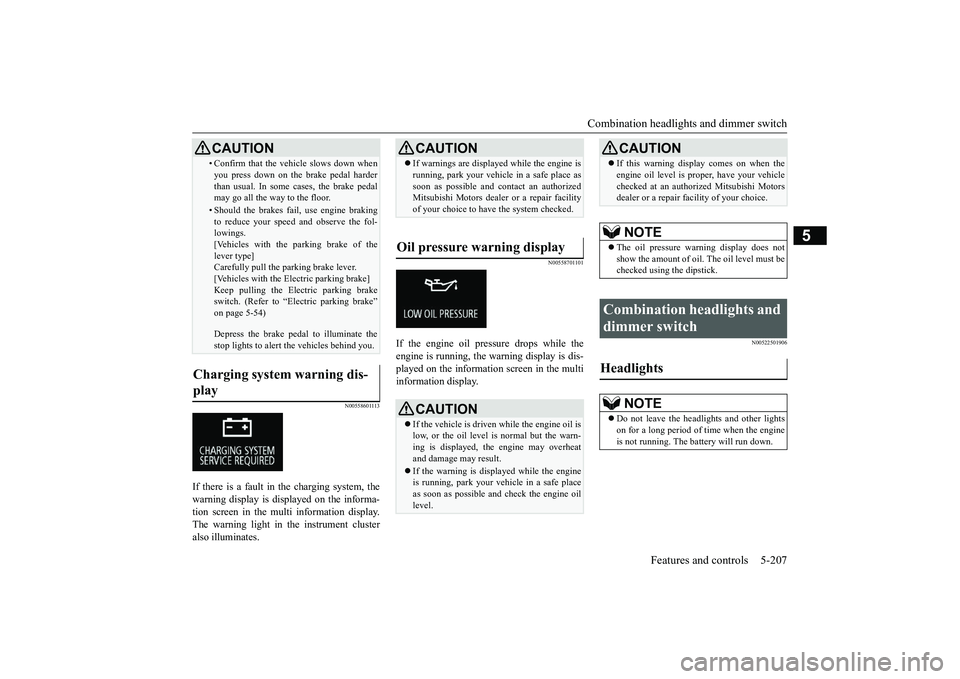
Combination headlights and dimmer switch
Features and controls 5-207
5
N00558601113
If there is a fault in the charging system, thewarning display is di
splayed on the informa-
tion screen in the multi information display.The warning light in the instrument clusteralso illuminates.
N00558701101
If the engine oil pressure drops while theengine is running, the
warning display is dis-
played on the information screen in the multiinformation display.
N00522501906
• Confirm that the vehicle slows down whenyou press down on the brake pedal harderthan usual. In some cases, the brake pedalmay go all the way to the floor.• Should the brakes fail, use engine brakingto reduce your speed and observe the fol-lowings.[Vehicles with the parking brake of thelever type]Carefully pull the pa
rking brake lever.
[Vehicles with the Electric parking brake]Keep pulling the Elec
tric parking brake
switch. (Refer to “Electric parking brake”Depress the brake pedal to illuminate thestop lights to alert th
e vehicles behind you.
Charging system warning dis-play
CAUTION
CAUTIONIf warnings are displaye
d while the engine is
running, park your vehicl
e in a safe place as
soon as possible and contact an authorizedMitsubishi Motors dealer
or a repair facility
of your choice to have the system checked.
Oil pressure warning display
CAUTIONIf the vehicle is driven while the engine oil islow, or the oil level is normal but the warn-ing is displayed, th
e engine may overheat
and damage may result.If the warning is displayed while the engineis running, park your ve
hicle in a safe place
as soon as possible and check the engine oillevel.
If this warning display comes on when theengine oil level is prope
r, have your vehicle
checked at an author
ized Mitsubishi Motors
dealer or a repair fa
cility of your choice.
NOTE
The oil pressure warning display does notshow the amount of oil. The oil level must bechecked using the dipstick.
Combination headlights and dimmer switch Headlights
NOTE
Do not leave the head
lights and ot
her lights
on for a long period of time when the engineis not running. The battery will run down.CAUTION
BK0249100US.book 207 ページ 2017年5月10日 水曜日 午前8時49分
Page 334 of 441

Driving during cold weather
Driving safety 6-5
6
you give extra attention to the followingareas, you can better protect yourself andyour passengers:Drive defensively. Be aware of traffic,road and weather c
onditions. Leave plenty
of stopping distance
between your vehicle
and the vehicle ahead.Before changing lanes, check your mir-rors, blind spots, a
nd use your turn-signal
light.While driving, watch the behavior ofother drivers, bicycl
ists, and pedestrians.
Always obey applicab
le laws and regula-
tions. Be a polite and alert driver. Alwaysleave room for unexpected events, such assudden braking.If you plan to drive in another country,obey their vehicle re
gistration laws and
make sure you will be able to get the rightfuel.
N00629400445
Check the battery. At the same time,check the terminals and wiring. Duringextremely cold weather, the battery willnot be as strong. Also, the battery powerlevel may drop beca
use more power is
used for cold starting and driving.
Before driving the vehicle, check to see ifthe engine runs at the proper speed and ifthe headlights are as bright as normally.Charge or replace the battery if necessary.During extreme cold weather, it is possi-ble that a very low battery could freeze.Warm the engine sufficiently. After start-ing the engine, allow a short warm-uptime to distribute oil to all cylinders. Thendrive your vehicle slowly.Stay at low speeds at first so that thetransaxle, transfer case and rear axle oilhave time to spread to all lubricationpoints.Check the engine antifreeze.If there is not enough coolant because of aleak or from engine
overheating, add Mit-
subishi Motors Genuine Super Long LifeCoolant Premium or equivalent.Please read this section in conjunctionwith the “Engine coolant” on page 9-8.
N00629501528
All the parts of the brake system are criticalto safety. Have the
vehicle serviced by an
authorized Mitsubishi Motors dealer or arepair facility of your
choice at regular inter-
vals according to the “WARRANTY ANDMAINTENANCE MANUAL”.Check the brake system while driving at alow speed immediately
after starting, espe-
cially when the brakes are wet, to confirmthey work normally.A film of water can be formed on the brakediscs and prevent normal braking after driv-ing in heavy rain or through large puddles, orafter the vehicle is washed. If this occurs, drythe brakes out by drivi
ng slowly while lightly
depressing the brake pedal.
Driving during cold weather
WA R N I N GThe battery gives off explosive hydrogengas. Any spark or flame can cause the bat-tery to explode, which could cause seriousinjury or death.Always wear protecti
ve clothes and a face
mask when working with your battery, orlet a skilled mechanic do it.
WA R N I N GNever open the radiator cap when theradiator is hot. You could be seriouslyburned.
Braking When brakes are wet
BK0249100US.book 5 ページ 2017年5月10日 水曜日 午前8時49分
Page 342 of 441

Trailer towing
Driving safety 6-13
6
Tongue loads can be adjusted by proper dis-tribution of the load in the trailer. This can bechecked by separately
weighing the loaded
trailer and then the tongue.The GAWRs are printed on the certificationlabel which is riveted on the door sill on thedriver’s side.Refer to “Vehicle labeling” on page 11-2.Choose a proper hitch and ball, and makesure it is installed at a height that is compati-ble with the trailer.Use a good equalizing hitch which uniformlydistributes the trailer tongue load throughoutthe frame.
A safety chain must al
ways be used between
the towing vehicle and the trailer. Leave suf-ficient slack in the chain for turns. The chainshould cross under the trailer tongue to pre-vent the tongue from dropping to the groundin case it becomes damaged or separated.For correct safety chai
n procedures, consult
your authorized Mitsub
ishi Motors dealer.
Your vehicle will need service more oftenwhen you’re towing a trailer. Refer to “WAR-RANTY AND MAINTENANCE MAN-UAL”. Especially important in traileroperation are automatic transaxle fluid,engine oil, rear axle
oil, belt, c
ooling system
and brake system. Each
of these is covered in
this manual.For details, please refer to the “Vehicle careand maintenance” section.Check periodically to see that all hitch nutsand bolts are tight.Mitsubishi Motors recommends that anytrailer having a total we
ight of 1,250 lbs (567
kg) or more (2400 models), 1,400 lbs (635kg) or more (3000 mode
ls) be equipped with
its own electric or surge-type brakes.If you choose electric br
akes, be sure they are
electrically actuated. Do not attempt to tapinto your vehicle’s hydraulic system. No mat-ter how successful it
may seem, any attempt
to attach trailer brakes to your vehicle’shydraulic system will lower braking effec-tiveness and create a potential hazard.
Gross axle weight rating (GAWR) Trailer hitches
WA R N I N GIf you make any holes in the body of yourvehicle for installing
a trailer hitch, be
sure to seal the holes later when youremove the hitch. If
you don’t seal them,
deadly carbon monoxide (CO) from yourexhaust can enter your vehicle. Refer to“Exhaust system” on page 9-24.
NOTE
Mitsubishi Motors recommends that swaycontrol be used whenever you are towing, toimprove towing stability.For further informati
on, please contact your
authorized Mitsubishi Motors dealer.
Safety chains
CAUTIONNever tow a trailer wi
thout using a safety
chain securely attached to both the trailerand the vehicle. If the
coupling unit or hitch
ball experiences a probl
em, the trailer may
separate from
your vehicle.
Maintenance when trailer tow-ing Trailer brakes
BK0249100US.book 13 ページ 2017年5月10日 水曜日 午前8時49分
Page 344 of 441
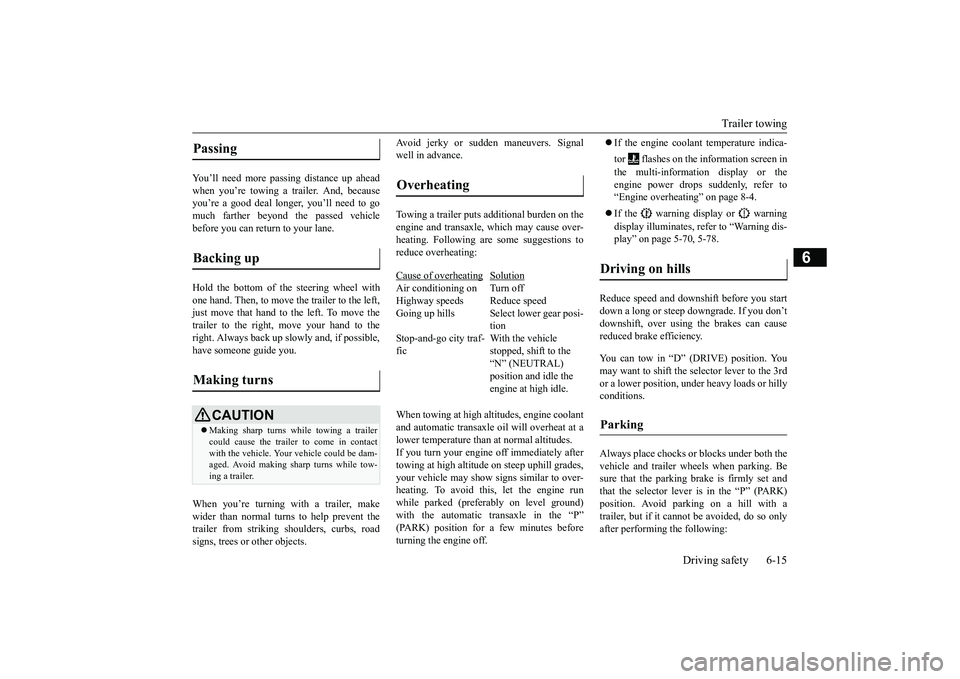
Trailer towing
Driving safety 6-15
6
You’ll need more passing distance up aheadwhen you’re towing a trailer. And, becauseyou’re a good deal longer, you’ll need to gomuch farther beyond the passed vehiclebefore you can return to your lane.Hold the bottom of the steering wheel withone hand. Then, to move the trailer to the left,just move that hand to the left. To move thetrailer to the right, move your hand to theright. Always back up sl
owly and, if possible,
have someone guide you.When you’re turning with a trailer, makewider than normal turns to help prevent thetrailer from striking shoulders, curbs, roadsigns, trees or other objects.
Avoid jerky or sudden maneuvers. Signalwell in advance.Towing a trailer puts additional burden on theengine and transaxle,
which may cause over-
heating. Following ar
e some suggestions to
reduce overheating:When towing at high al
titudes, engine coolant
and automatic transaxle oil will overheat at alower temperature than at normal altitudes.If you turn your engine off immediately aftertowing at high altitude
on steep uphill grades,
your vehicle may show
signs similar to over-
heating. To avoid this
, let the engine run
while parked (preferably on level ground)with the automatic transaxle in the “P”turning the engine off.
If the engine coolant temperature indica-tor flashes on the information screen inthe multi-information display or theengine power drops suddenly, refer to“Engine overheati
ng” on page 8-4.
If the warning display or warningdisplay illuminates, re
fer to “Warning dis-
play” on page 5-70, 5-78.
Reduce speed and downshift before you startdown a long or steep downgrade. If you don’tdownshift, over using the brakes can causereduced brake efficiency.You can tow in “D” (DRIVE) position. Youmay want to shift the selector lever to the 3rdor a lower position, under heavy loads or hillyconditions.Always place chocks or blocks under both thevehicle and trailer wheels when parking. Besure that the parking brake is firmly set andthat the selector lever is in the “P” (PARK)position. Avoid parki
ng on a hill with a
trailer, but if it cannot be avoided, do so onlyafter performing the following:
Passing Backing up Making turns
CAUTIONMaking sharp turns while towing a trailercould cause the
trailer to come in contact
with the vehicle. Your
vehicle could be dam-
aged. Avoid making sharp turns while tow-ing a trailer.
Overheating Cause of overheating
Solution
Air conditioning on Turn offHighway speeds Reduce speedGoing up hills Select lower gear posi-
tion
Stop-and-go city traf-fic
With the vehicle stopped, shift to the “N” (NEUTRAL) position and idle the engine at high idle.
Driving on hills Parking
BK0249100US.book 15 ページ 2017年5月10日 水曜日 午前8時49分
Page 378 of 441

9
Vehicle care and maintenanceService precautions ..........................................................................9-2Catalytic converter ...........................................................................9-2Engine hood .........
...........
...........
............
...........
.........
........
.........
.....9-3
View of the engine compartment .....................................................9-5Engine oil and oil filter ....................................................................9-6Engine coolant .................................................................................9-8Air cleaner filter ...............................................................................9-9Automatic transaxle fluid (if so equipped) ..................................... 9-11Continuously variable transmission
(CVT) fluid (if so equipped) . 9-11
Transfer oil (All-wheel drive models) ...........................................9-12Rear axle oil (All-wheel drive models) .........................................9-12Washer fluid ...................................................................................9-12Brake fluid .....................................................................................9-13Battery ............................................................................................9-13Tires ...............................................................................................9-15Brake pedal free play .....................................................................9-22Parking brake lever stroke (if so equipped) ....................................9-22Wiper blades ..................................................................................9-22Emission-control system maintenance ..........................................9-23General maintenance .....................................................................9-24For cold and snowy weather ..........................................................9-25Fusible links ...................................................................................9-25Fuses ..............................................................................................9-26Replacement of light bulbs ............................................................9-31Vehicle care precautions ................................................................9-39Cleaning the inside of your vehicle .......
...........
...........
...........
.......9-40
Cleaning the outside of your vehicle .....
...........
...........
...........
.......9-41
BK0249100US.book 1 ページ 2017年5月10日 水曜日 午前8時49分
Page 382 of 441
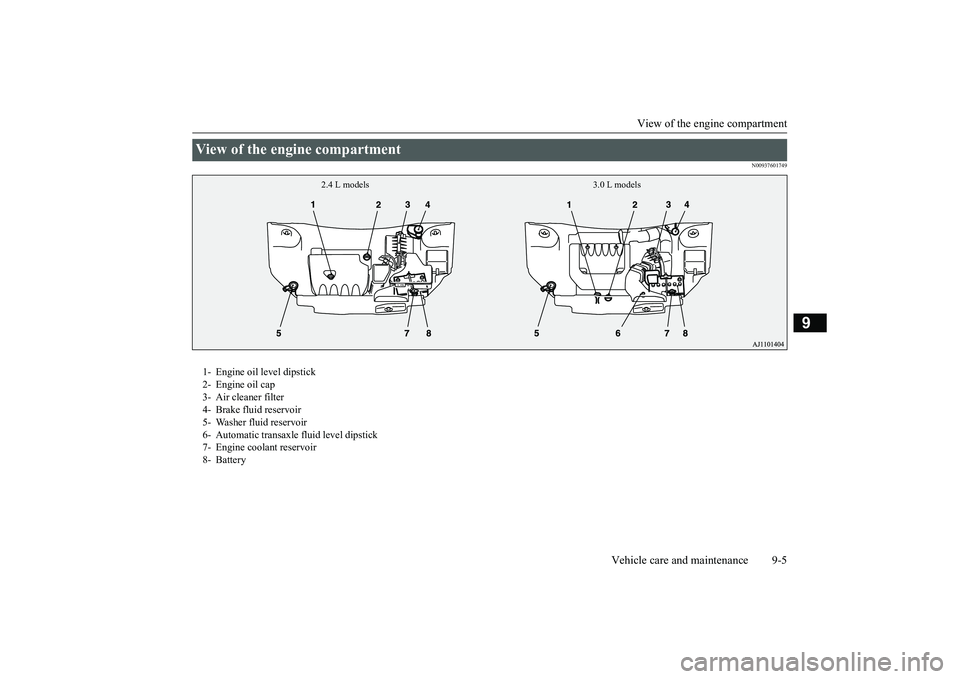
View of the engine compartment
Vehicle care and maintenance 9-5
9
N00937601749
View of the engine compartment
2.4 L models 3.0 L models
1- Engine oil level dipstick2- Engine oil cap3- Air cleaner filter4- Brake fluid reservoir5- Washer fluid reservoir6- Automatic transaxle fluid level dipstick7- Engine coolant reservoir8- Battery
BK0249100US.book 5 ページ 2017年5月10日 水曜日 午前8時49分